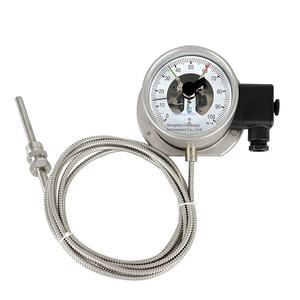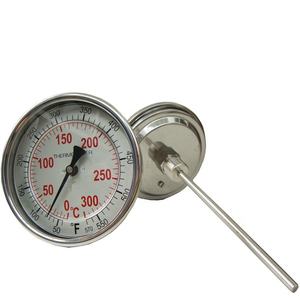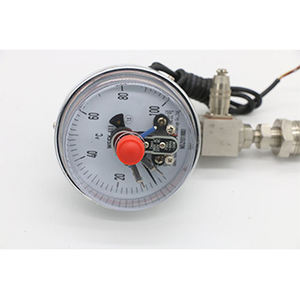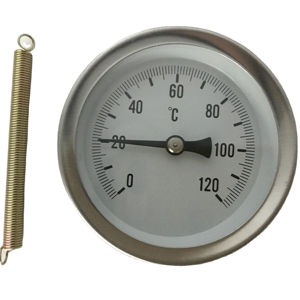Electronic Components Supplier | Transformers, Inductors, Inverters
PRODUCT PARAMETERS
Description
Overview of Industrial TEMPERATURE TRANSMITTERS Digital Thermometer Bimetallic Thermometer and Shock Resistant Pressure Gauge
Industrial TEMPERATURE TRANSMITTERS Digital Thermometer Bimetallic Thermometer and Shock Resistant Pressure Gauge is used to monitor the temperature during industrial production processes, which are crucial for equipment operation, product quality, and production safety. There are various types, such as thermal resistance thermometers, thermocouple thermometers, infrared thermometers, optical thermometers, etc., each with its advantages, disadvantages, and applicable ranges, which need to be selected according to specific usage environments and measurement requirements. Regularly inspect and calibrate to ensure accuracy and reliability, providing reliable temperature measurement data for industrial production. Choosing and using industrial thermometers correctly can ensure the smooth progress of the industrial output.
Characteristics of Industrial TEMPERATURE TRANSMITTERS Digital Thermometer Bimetallic Thermometer and Shock Resistant Pressure Gauge
High precision measurement: It usually has a high-precision temperature measurement function, which can accurately measure and display temperature values. This is thanks to the use of precision temperature sensors and measurement circuits.
Wide temperature range: able to adapt to a wide range of temperatures and measure and control industrial processes from extremely low to high temperatures. Different models of temperature controllers may have different temperature ranges, and users can choose the appropriate model according to their specific needs.
Multiple control modes: Usually supports multiple control modes, such as proportional control, PID control, fuzzy control, etc. These control modes can be selected and adjusted according to actual needs to achieve precise temperature control and stability.
Multiple output modes: With multiple output modes for communication and control with other devices or systems. Common output methods include analog output (such as current or voltage signals), digital output (such as RS485 communication interface), and relay output.
Large screen display: Provided with a large screen display, it can clearly display the current temperature, set temperature, and other related information. This allows users to visually monitor temperature changes and device status, making it convenient to operate and adjust parameters.
Strong anti-interference ability: There are often various sources of interference in industrial environments, such as electromagnetic interference, vibration, and temperature fluctuations. Industrial thermometers usually have strong anti-interference ability, and anti-interference design and filtering algorithms are adopted to reduce the impact of interference on temperature measurement and control.
Programmable function: With programmable function, users can customize settings and operations according to their needs. Users can set temperature curves, time control, and alarm functions through the programming interface to meet the needs of complex industrial processes.
Security protection function: usually has multiple security protection functions to ensure the safety of equipment and processes. For example, it can have functions such as over temperature protection, power outage memory, and fault alarm to prevent timely measures from being taken in case of temperature exceeding the safe range or equipment failure.
Easy installation: Industrial thermometers can be installed in various ways, such as axial, radial, and universal, making it convenient for users to use.
Good durability and reliability: Industrial thermometers are usually made of high-quality materials and processes, which have good durability and reliability and can work stably for a long time.”
Specification of Industrial TEMPERATURE TRANSMITTERS Digital Thermometer Bimetallic Thermometer and Shock Resistant Pressure Gauge
Industrial temperature transmitters transform readings from sensing units like RTDs or thermocouples into conventional signals. They send out these signals over long distances to manage systems. These devices offer high precision. They are essential for exact process control. Users get dependable temperature data from another location. This is vital in factories and power plants. The signals are generally 4-20mA or digital layouts like HART. This ensures compatibility with existing tools. Transmitters operate in difficult environments. They take care of high temperatures and vibrations well. Installation is straightforward. Upkeep needs are low. They enhance total system efficiency and safety.
Bimetallic thermostats are straightforward, mechanical gadgets. They make use of two various steels bound together. These steels increase at various rates when heated up. This movement drives a tip on a dial. The dial shows the temperature level plainly. These thermostats are very robust. They need no external source of power. This makes them sure. They are excellent for direct, local temperature level readings. You see them on pipes, storage tanks, and machinery. They take care of heats successfully. Precision is good for lots of commercial uses. They are likewise affordable. Resilience is a significant advantage. They stand up to shock and vibration well.
Shock-resistant pressure determines are built tough. They shield the interior device from impacts and pulsation. This is essential in harsh commercial settings. Hydraulic systems, compressors, and pumps commonly cause resonance. These evaluates withstand that tension. They use unique motions and fluid filling. The liquid dampens guideline movement. It also lubricates internal parts. This prevents use from resonance. The dial remains readable under challenging conditions. Security is a key advantage. They prevent scale failure. This stays clear of possible risks. Precision stays steady over time. They are trusted for critical pressure tracking. Steel plants and chemical handling count on them.
Applications of Industrial TEMPERATURE TRANSMITTERS Digital Thermometer Bimetallic Thermometer and Shock Resistant Pressure Gauge
Industrial temperature level transmitters are important devices. They transform temperature level readings from sensing units right into common signals. These signals take a trip cross countries easily. Control systems and checking devices receive them. This allows remote surveillance and control. Plants rely on them for procedure effectiveness. They make certain product high quality and safety and security. Their robust layout deals with extreme manufacturing facility problems. Dust, dampness, and vibration do not quit them. Accuracy is vital for these devices.
Digital thermometers offer precise temperature level readings. They show numbers plainly on an LCD screen. Employees see the exact temperature level quick. This is crucial for quick decisions. They often feature information logging. This documents temperature changes over time. Battery life is normally long. Durability is important for industrial use. They are preferred for spot checks. They are likewise used for continual tracking. Their convenience of use is a large benefit.
Bimetallic thermometers are simple and reputable. They use 2 different steels adhered with each other. These steels expand at various rates when heated up. This triggers a tip to proceed a dial. They require no outside power source. This makes them extremely reputable. They prevail where power is dangerous. They are additionally utilized for basic regional analyses. Their mechanical nature is simple. Upkeep is marginal. They are a cost-efficient solution.
Shock resistant pressure assesses are developed difficult. They protect the internal mechanism. Impacts and resonances happen frequently in market. These assesses hold up against hefty knocks. They typically have a liquid-filled situation. This dampens needle activity. It makes the analysis stable. Workers can see the pressure clearly. Process stability relies on precise pressure control. These evaluates prevent pricey downtime. Leakages and failures are reduced. Safety and security is boosted significantly. They are important for pumps, compressors, and hydraulic systems. Plant team appreciate their longevity.
Company Profile
PDDN Photoelectron Technology Co., Ltd. is one of the leading enterprises in power electronics technology and power products, which is fully involved in developing solar inverters, transformers, voltage regulators, distribution cabinets, thyristors, modules, diodes, heaters, and other electronic devices or semiconductors. We will be committed to providing users with high-quality, efficient products and considerate service.
It accepts payment via Credit Card, T/T, West Union, and Paypal. PDDN will ship the goods to customers overseas through FedEx, DHL, by sea, or by air. If you want high-quality Industrial TEMPERATURE TRANSMITTERS Digital Thermometer Bimetallic Thermometer and Shock Resistant Pressure Gauge, please send us inquiries; we will be here to help you.
Payment Methods
L/C, T/T, Western Union, Paypal, Credit Card etc.
Shipment
By sea, by air, by express, as customers request.
Storage Conditions
1) Store in a dry environment at room temperature.
2) Avoid damp and high temperature.
3) Use immediately after opening the inner packing bag.
5 FAQs of Industrial TEMPERATURE TRANSMITTERS Digital Thermometer Bimetallic Thermometer and Shock Resistant Pressure Gauge
What do industrial temperature transmitters actually do?
They take temperature readings from sensors like RTDs or thermocouples. The transmitter converts this raw signal. It turns it into a standard output signal. Common outputs are 4-20mA or digital signals. This standard signal travels long distances to control systems. Control systems then use this data for monitoring or automatic control.
How accurate are digital thermometers compared to other types?
Digital thermometers generally offer high precision. They are often more accurate than bimetallic thermometers. Their digital display gives clear, easy-to-read numbers. This reduces reading errors. Accuracy depends on the sensor quality and calibration. Good digital models are reliable for critical measurements.
Why pick a bimetallic thermometer?
Bimetallic thermometers are simple and tough. They use a metal coil that bends with temperature changes. This moves the pointer on the dial. They need no batteries or external power. They are very cost-effective for basic temperature checks. You see them on pipes or tanks where simplicity matters most.
Where are shock-resistant pressure gauges needed?
Use them in tough spots with lots of vibration or bumps. Machinery, hydraulic systems, and compressors cause heavy shaking. Normal gauges fail quickly there. Shock-resistant gauges have special internal designs. These designs absorb vibration energy. They protect the movement mechanism. This gives a longer lifespan and reliable readings in rough conditions.
Do these instruments need special care?
Yes, basic maintenance keeps them working right. Check them regularly for physical damage or leaks. Calibrate them periodically. Calibration ensures readings stay accurate over time. Follow the maker’s instructions for cleaning and safe use. Protect gauges and transmitters from extreme conditions beyond their ratings. This care prevents failures.
REQUEST A QUOTE
RELATED PRODUCTS

All Stainless Steel Thermometer Industrial Temperature Meter 80 mm Universal Connection Temperature Gauge

Lcd Digital Thermometer Hygrometer Higrometer Mini Temperature Sensor Thermo Hygrometer

ODM 0-5V 4-20mA RS485 Non-Contact Industrial Digital Laser Infrared Temperature Thermometer Pyrometer IR Thermal Sensors

Anticorrosive Chemical Industry Industrial Thermometer Bimetal Thermometer WSS-411 Stainless Steel Thermometer

Industry-leading Calibration Thermometer with Calibration Function Portable Design in Electronic Component Testing


